Australian Eclectus (Eclectus roratus macgillivrayi)
This, the largest of the nine subspecies of Eclectus Parrot, is found only in Australia and only in a very small location of eastern Cape York Peninsula in the state of Queensland. The Australian Eclectus is much larger than the New Guinea Eclectus, at 16 inches (42cm) in length and has a 7inch (18cm) tail. This subspecies was only discovered in 1913, so It is the most recently described. The Australian Eclectus has the most southerly range and its security is assured, due to its total protection and the formation of national parks that now covers most of their habitat.
Australian Eclectus are very familiar to me personally. I first became interested in them way back in 1968, when I was leading a documentary film crew to the wilds of Cape York peninsula to film the Great Palm Cockatoo Probosciger aterraimus macgillivrayi. During the two months filming the Palm Cockatoo, we started to notice these large red and blue and iridescent green parrots flying through the lush rainforest. I can still vividly remember my first sighting of these beautiful birds. My wife and our two and a half year old daughter and I were out scouting for nesting locations for the film crew to film the next day, when I heard what I thought was an Eclectus parrot call some distance into the forest. We slowly walked along the edge of a small creek, trying not to make a sound, when suddenly off flew this large bright green male squawking his head off. We crept closer to the tree that we thought he flew from, and looking through my binoculars, I could see a couple of suitable nesting hollows. I decided to tap the tree with a large branch to see if the female was sitting. After a couple of taps she stuck her head out to see what the noise was, then she saw us and out she flew. We decided to move to another position a little further away from the nest tree, but in a spot where we could see the nest entrance. We hid ourselves among the pandanus palm fronds and branches and sat very quite. About ten minutes later I heard them calling. I thought they were coming back to their nest, but they landed in the top branches of the tree looking down to where we were before. I knew if we sat silently and did not move, we may see them return to the nest. After a short time, the female flew down to the nest followed by the male. This site we saw will stay with us forever; these beautiful brilliantly coloured parrots, sitting just meters away in the morning sunlight, took our breath away.
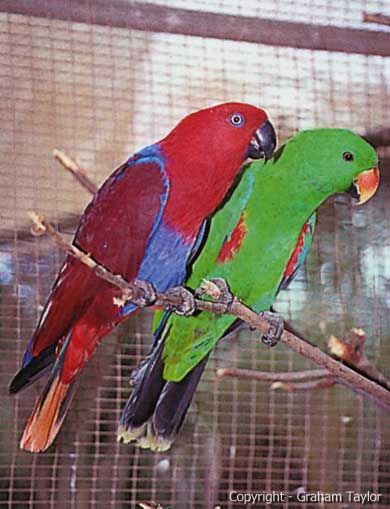 Caption 001: Pair of Eclectus roratus macgillivrayi-The Australian Eclectus. Note: This photo of the Australian Eclectus was taken by Russell Kingston at the Pearl Coast Zoo in Broome Western Australia. Adult breeding pair. 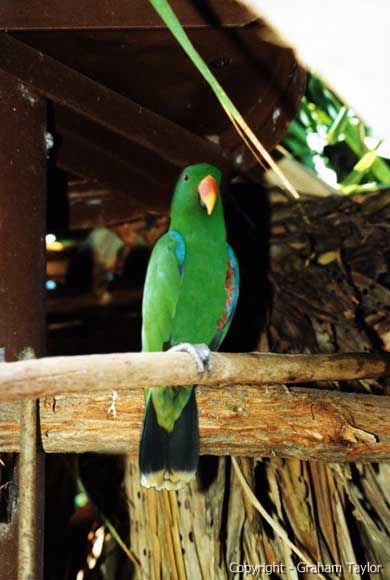 Caption 002: Adult male Australian Eclectus-Graham Taylor. Note: This photo of the male Australian Eclectus was taken at the Pearl Coast Zoo in Broome Western Australia. 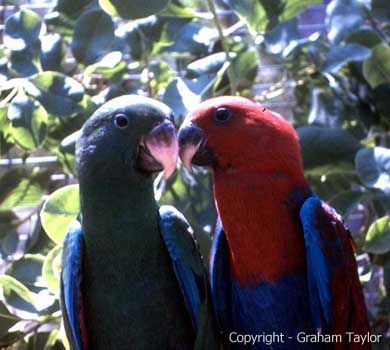 Caption 003: Juvenile pair of Australian Eclectus-Graham Taylor. Note: This is a photo of the first pair of Australian Eclectus Parrots to be collected from the wild in 1974. 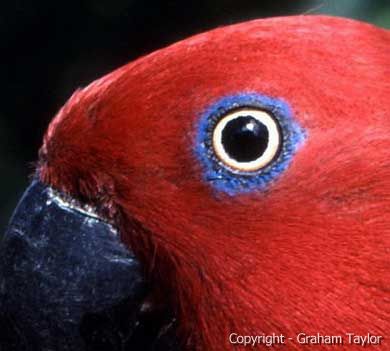 Caption 004: Head and eye ring of the female Australian Eclectus. Note: This photo shows the distinct colour of the eye ring and the blue feathering around the eye of this adult female Australian Eclectus-Graham Taylor. 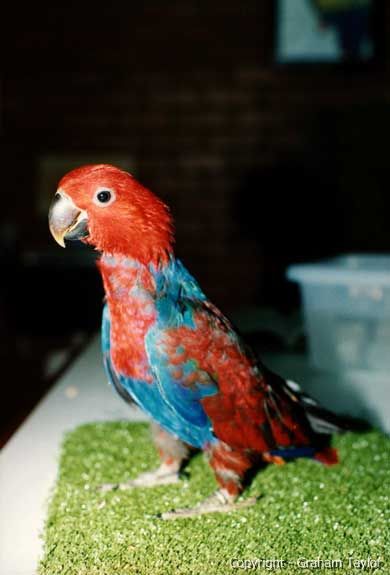 Caption 005: Fledgling-Australian Eclectus-Graham Taylor. Note: This was one of the first Australian Eclectus parrots bred at the Pearl Coast Zoo in Broome Western Australia. 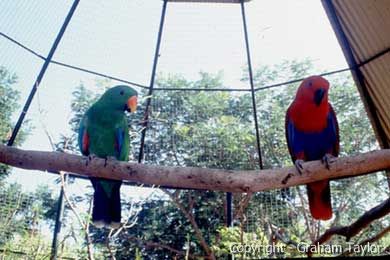 Caption 006: Pair of Australian Eclectus Parrots at Pearl Coast Zoo-Graham Taylor. Note: Adult pair of Australian Eclectus parrots, housed in a very large aviary at the Zoo in Broome, Western Australia. |
